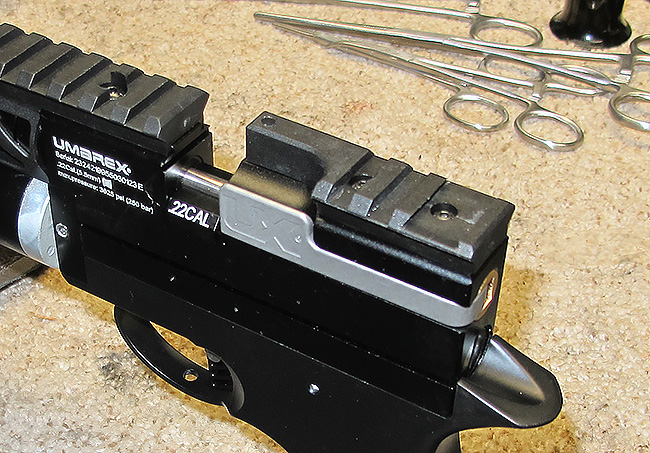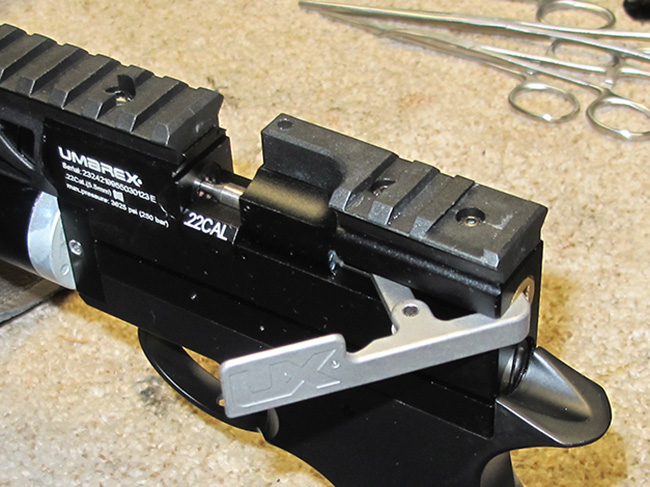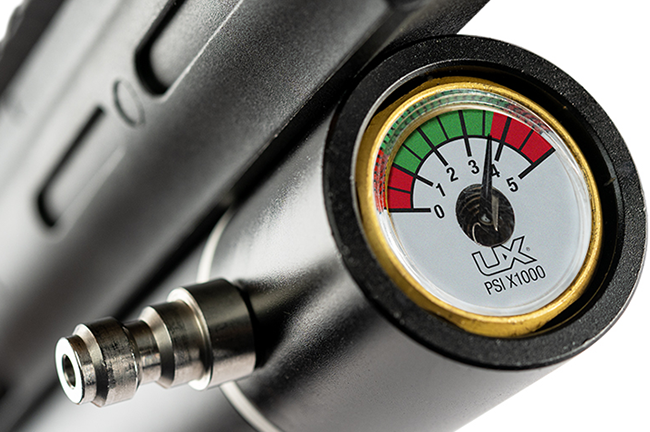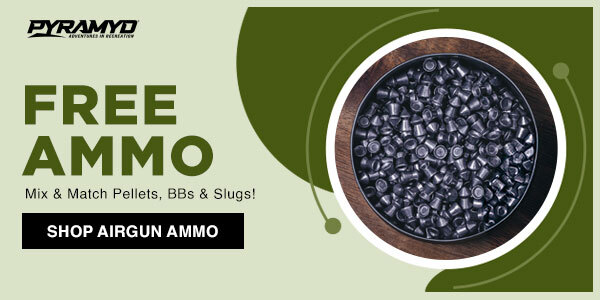This report covers:
- Expected velocity
- Today’s test
- Crosman Premiers
- JTS Dead Center 18.1-grain dome
- JSB Exact RS
- The cocking lever
- Shot count
- Discussion
- Summary
Today we look at the velocity of the Umarex Notos I bought to test and modify. In Part 2 I explained how I got to this point.
Expected velocity
I shot the Notos with three pellets — a lightweight, a medium weight and one that was heavy for the expected power of the rifle. I based my selections on the expected power of the air rifle, though you may remember there was wide disparity over what that might be. The manual says to expect a velocity of 780 f.p.s. but of course it doesn’t mention what weight pellet was used. The Pyramyd AIR website description says to expect 700 f.p.s. as of the day this report is published, but they may change that at any time. Tyler Patner tested a Notos and made an Insyder video. In that one he got:
709 f.p.s. average from a JSB Heavy 18.1 with a spread of 17 f.p.s. and 23 shots max.
Tyler is the only one who gives us the pellet he uses and he also gives the extreme spread and the shot count for that pellet. I will have more to say about the shot count that I got today, and it’s something I mentioned in Part 2 yesterday, so if you haven’t read that report and you are interested in a Notos, you might want to read it.
Today’s test
I started by filling the Notos — and here is an important note. I filled the rifle using the gauge on the Notos — not the gauge on my carbon fiber tank. I know the gauge on my carbon fiber tank is spot-on, but I wanted to see what would happen if I used the Notos’ gauge. As I mentioned in Part 2, that gauge reads about 300 psi lower than the one on my fill tank — so I put more air into the Notos. I filled to the maximum on the Notos gauge scale — the highest green point, but not into the red.
I shot 10-shot strings. Seven pellets were shot from the rotary magazine and the last three were shot using the single-shot loader. In Part Two I explained that this allowed me to test both the rotary magazine and the single-shot tray. After the first string I went from the Umarex magazine and single-shot tray and started using the Maple Custom Products magazine and single-shot loader because the factory magazine was dropping pellets before I could get it inserted all the way into the receiver.
Crosman Premiers
Crosman Premiers were the first pellet I tested. This 14.3-grain pellet averaged 760 f.p.s. for 10 shots. The low was 753 and the high was 764, so a spread of 11 f.p.s. At the average velocity this pellet generated 18.35 foot-pounds at the muzzle.
JTS Dead Center 18.1-grain dome
Ten JTS Dead Center 18.1-grain domes averaged 702 f.p.s. for 10 shots. There was an unrecorded shot in this string so this added 11 shots to the total count. The low was 701 and the high was 705 f.p.s. for an extreme spread of 4 f.p.s. At the average velocity this pellet generated 19.81 foot-pounds at the muzzle. Given the power of this rifle this is about the heaviest weight pellet I would select.
JSB Exact RS
The lightest weight pellet was the last to be tested — the 13.43-grain JSB Exact Jumbo RS. Ten of them averaged 790 f.p.s., so there’s the manual-stated velocity of 780. The low was 784 and the high was 794 f.p.s. for a 10 f.p.s. spread. At the average velocity this pellet generated 18.62 foot pounds of energy at the muzzle.
Discharge sound
The Notos discharged with 97.5 decibels of sound. That might sound high but to my ears that were wearing hearing aids it wasn’t that bad. I would call it friendly for larger backyards.
The cocking lever
I showed the cocking lever pulled back yesterday but I didn’t comment on it. Today I will. The cocking lever sits flush to the left side of the Notos’ extremely thin receiver. I said in Part 1 that is the perfect place for it on a pistol held by a right-handed shooter. On a rifle I’m not as sure. Of course the pellets are being fed from a magazine, so perhaps it isn’t bothersome. I’ll have to wait to see when I start shooting for accuracy.

The cocking lever is flush to the left side of the receiver.

The cocking lever is opened but the rifle is not yet cocked.
I do note that the receiver is scalloped out behind the cocking lever, so it’s easy to grab when you need to.
Shot count
I had every intention of refilling the reservoir for the third shot string. But as you can see, it wasn’t necessary. So after those 31 shots (remember the 11 shots on string two) I went back to the Crosman Premiers and kept shooting. Let’s see that now.
Shot……….Vel.
32………….767
33………….763
34………….765
35………….761
36………….759
37………….754
38………….746
39………….745
40………….741
41………….730
The rifle obviously fell off the power curve on shot 36. But that is a lot more full-power shots than Tyler recorded, which was 23. What happened?
Discussion
Remember that I filled the Notos while following the onboard gauge? That put more air into the reservoir. That is the difference. If I had filled by my carbon fiber tank gauge the shot count would have been lower. At the end of the shots the onboard gauge read just under 2000 psi (1980?). So if I use the onboard gauge I get 30 shots from the Notos with a safety cushion.
Summary
So far the Notos has shown good potential. I know I panned the rotary magazine, but that was the only flaw I see so far. If this rifle will shoot I think we have a winner on hand!
Next we will look at the accuracy of the Notos. After that I will be looking at a number of aftermarket accessories and modifications that are possible. I expect this to be a longer report series.



BB,
As a non-darksider, even I have to admit that this thing is pretty cool: short, light, handy, good shot count.
Now, the question is, “can she shoot?”
I guess we’ll find out soon. 🙂
Blessings to you,’
dave
Would love to see how Crosman Ultra Heavy (19 grain) would do.
I wonder how safe it is to have the tank filled up to almost 4000 psi. If I understood correctly this was the actual pressure according to first part’s findings about the gauge.
Bill,
As is noted in my below post, the test pressures for PCP tanks is waaaaay above 4000 PSI, so you should have no fear concerning this small pressure difference.
The issue that usually raises its ugly head is at what pressure does the valve efficiently and properly operate at. Most airgun valves operate at 2000 PSI or below. This is one of the reasons for regulators. They are used to lower the output pressure to what the valve can operate properly at.
Yes, there are some airgun valves designed to operate at higher pressures, but not that many. At one point many valves were designed to operate at up to 3000 PSI or even higher, but it required a stronger hammer spring to open them.
Manufacturers soon found that with the use of regulators they could reduce the pressures at which valves operated at and allow such incredible fill pressures upstream of the regulators. There are limitations though. Some manufacturers have been using more than one regulator to step the pressure down as the less pressure difference the better and more controlled the output can be, but regulator design has been improving over the years also.
If you are wowed by 4000 PSI, hold on tight.
Hold on tight.
AEA has released a compressor that is rated to fill 7000psi.
So it isn’t breaking a sweat to fill a 4500 psi tank.
And I THINK they have released a big bore that fills to 6000 psi.
Ian.
Ian,
That does not really surprise me. As for myself, I am looking for an airgun that fills to 1000 PSI. TCFKAC is heading in the right direction. I just wish I could speak directly with their engineers and maybe even their marketeers. 6000 PSI?! Really?! Not me.
B.B.
At the range some speed shooters can empty a 12 shot magazine in less than 10 seconds. They l have their trigger finger and cocking hand well synchronised. How do think the cocking lever and cocking effort on this Notos would fair similarly?
I do hope that at some point you shoot this as just a pistol…
-Y
Yogi, I don’t know about Tom’s experience with it so far , but in shooting a couple of the Notos’s of friends my thoughts are.
It’s a small light easy to carry and use carbine.
Not really designed for speed.
Could you possibly do it?
Yes possibly.
But for me, I just don’t think it fits that philosophy of use.
Just my personal thoughts.
Ian.
Thanks for the well-done report. It looks like the velocities are in the same ballpark as what I have experienced. One thing I noticed is the fill port on your rifle is at the nine o’clock and three o’clock positions when looking at the gauge. Mine is at the ten and four o’clock positions. Looking forward to the accuracy tests.
BB,
I must admit to a personal bias concerning the Notos. I myself would prefer the Jet 2 from Hatsan or the RP from Reximex as these companies are in Turkey which is technically a part of Europe. If I am not mistaken, the Notos is made by Wang Po Industries, one of Uncle Xi’s buddies.
Another reason for my personal bias is that this is not that old. I have in the past and am returning to the “old gals” that are no longer made. I know recently I have made a divergence into more modern airguns and I do enjoy following along on the explorations of the modern airguns, but when it comes to having them come live here at RRHFWA…
BB,
About the gauge thing, it took me a little while to wrap my head around it. Yeah, I can be real slow at times. My thinker is telling me that when you fill the tank with air to the onboard gauge, you are actually filling the tank to around 3925 PSI instead of 3625 PSI. Is my thinker working correctly on this?
To be of some reassurance to Bill, most PCP tanks are tested to well over 5000 PSI. Some are tested to over 7000 PSI if my rememberer is working correctly. In this as in all things, I must defer to the vast knowledge base of our host.
RR,
You are correct on the pressure thing.
Air cylinders are typically tested to at least 5/3 of their rated pressure. So the Notos would be proofed to 6041.67 psi as a minimum.
BB
BB,
As usual I am late, catching up after a long trip, so sorry for that. I purchased a Notos some 200 pellets ago so I can’t pretend that I know much about it. That said, I want to share some of my early observations but I will limit my comments to things you already mentioned. Regarding shooting results, I will only say that it is not bad for a short carbine.
Joining the crowd, I also dislike the magazine. At first it was hard to load and insert but – I have to admit – after some use it works much better. It didn’t spill any pellets, yet, but I am treating it with kids gloves. I fully loaded it, shot a couple of pellets and removed the rest. Using a magnifier I could not see skirt damage on them. That said, I will soon get an aftermarket magazine but I plan to keep the factory one as a backup. By the way, I do like the single shot tray you bought, it seems much easier to use than the OEM. Let us know how it works for you.
I felt that the cocking lever placement on the left side was awkward, but after a while I got used to it. It offers very little purchase for the finger, so it is OK for the bench, but with gloves it may not work. Not ideal for a hunting carbine.
The only issue I have with it is with the ergonomics, which is of course a personal preference. In order to get a proper cheek weld I had to mount the scope quite high using a rail adapter and tall rings. That said, the Bugbuster looks just right on top of the Notos.
I haven’t searched the after market yet, but I would not be surprised if someone makes a replacement stock that fits me better, if not I trust they will soon do. While I am wishing, I would not mind it being a folding stock making easier to transport this light carbine.
Best,
Henry
Henry,
One of the things I will be testing is an aftermarket stock from Buck Rail.
BB